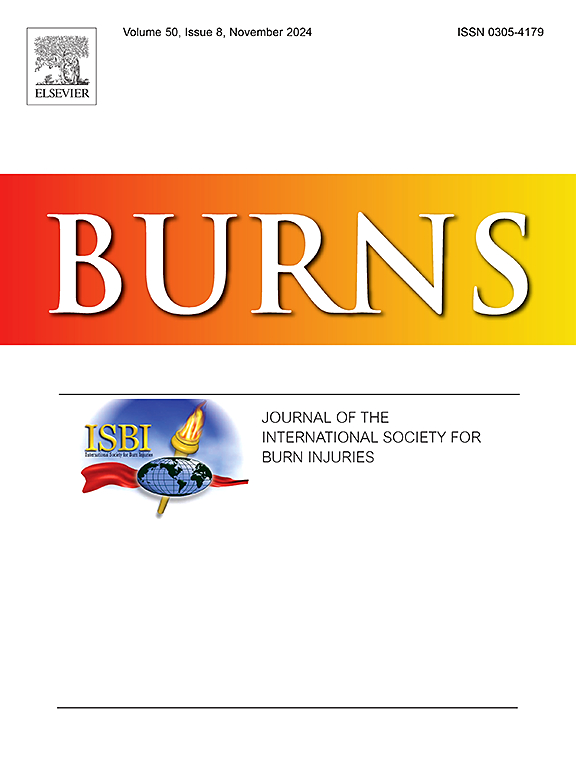静脉-动脉二氧化碳分压差和中心静脉氧饱和度对大面积烧伤危重患者输液和死亡率的预测价值
IF 2.9
3区 医学
Q2 CRITICAL CARE MEDICINE
引用次数: 0
摘要
目的指导严重烧伤患者的液体治疗面临着复杂的挑战,既有分布性休克,也有低血容量性休克,并伴有心血管功能障碍。虽然脓毒性休克的部分血流动力学评估,如中心静脉氧饱和度(ScvO2)和动静脉二氧化碳(CO2)分压差(ΔpCO2 = pcvCO2 - paCO2)都可以作为低灌注的指标,但它们不是严重烧伤患者的标准临床评估的一部分。因此,本回顾性研究的目的是调查严重烧伤患者的ΔpCO2和ScvO2是否与液体给药和死亡率相关。方法回顾性分析2017年1月至2021年6月瑞士苏黎世大学医院烧伤中心收治的烧伤总面积(TBSA)大于20% %的严重烧伤患者。患者根据国际指南和内部标准进行治疗,并在重症监护室入院的前24 小时内至少评估ΔpCO2和ScvO2一次。结果共纳入69例患者。中位ΔpCO2和ScvO2分别为1.16 kPa[四分位数间距IQR, 0.82 - 1.50]和76 % [IQR, 71 - 81]。这导致53例(77 %)患者ΔpCO2 (>0.8 kPa)异常升高,13例(19 %)患者ScvO2异常降低(<70 %)。初始Δ二氧化碳分压,但不是ScvO2,与静脉流体非线性相关政府在接下来的24 h (estimatelog 9.6 L[95 %置信区间CI, 4.1 - 15.2), 0.001 p = )和48 h (estimatelog 6.0 L(95 % CI, 0.3 - 11.8), p = 0.039)。初始ΔpCO2(对数比值比orlog4.3[95 % CI, 1.1 - 20.9], p = 0.048)和ScvO2 (orlog0.1[95 % CI, 0 - 0.42], p = 0.034)均与院内死亡率呈非线性相关。然而,与死亡率的最佳关联是通过结合ΔpCO2和ScvO2来实现的,同时出现ΔpCO2和ScvO2异常的患者的预测死亡率为46 %[95 % CI, 23-71]。结论在严重烧伤患者中,ΔpCO2和ScvO2与烧伤程度和严重程度以及住院死亡率相关。然而,似乎只有ΔpCO2具有预测液体给药的潜力。包括这两个参数的多模式液体复苏方法可能在严重烧伤患者中显示出希望;然而,需要进一步的前瞻性研究来确定最佳阈值并验证其与临床液体复苏实践的结合。本文章由计算机程序翻译,如有差异,请以英文原文为准。
Predictive value of veno-arterial carbon dioxide partial pressure difference and central venous oxygen saturation for fluid administration and mortality in critically ill patients with extensive burns
Objectives
Guiding fluid therapy in severely burned patients presents complex challenges, combining elements of both distributive and hypovolemic shock, accompanied by cardiovascular dysfunction. Whereas parts of hemodynamic assessment in septic shock such as central venous oxygen saturation (ScvO2) and the arterial-venous carbon dioxide (CO2) partial pressure difference (ΔpCO2 = pcvCO2 - paCO2) can both be used as indicators of hypoperfusion, they are not part of the standard clinical assessment of severely burned patients. The aim of this retrospective study was thus to investigate whether the ΔpCO2 and ScvO2 in severely burned patients correlates with fluid administration and mortality.
Methods
Retrospective analysis of severely burned patients with burns larger than 20 % total body surface area (TBSA) admitted between 01/2017 and 06/2021 to the Burns Center of the University Hospital Zurich, Switzerland. Patients were treated according to international guidelines and in-house standards and ΔpCO2 and ScvO2 were assessed at least once within the first 24 h of intensive care unit admission.
Results
In total 69 patients were included in this analysis. The median ΔpCO2 and ScvO2 were 1.16 kPa [inter-quartile range IQR, 0.82 – 1.50] and 76 % [IQR, 71 – 81]. This translated to an abnormally elevated ΔpCO2 (>0.8 kPa) in 53 (77 %) and an abnormally reduced ScvO2 (<70 %) in 13 (19 %) patients. Initial ΔpCO2, but not ScvO2, was non-linearly associated with intravenous fluid administration in the following 24 h (estimatelog 9.6 L [95 % confidence interval CI, 4.1 – 15.2], p = 0.001) and 48 h (estimatelog 6.0 L [95 % CI, 0.3 – 11.8], p = 0.039). Both initial ΔpCO2 (logarithmic odds ratio ORlog 4.3 [95 % CI, 1.1 – 20.9], p = 0.048) as well as ScvO2 (ORlog 0.1 [95 % CI, 0 – 0.42], p = 0.034) were non-linearly associated with in-hospital mortality. However, the best association with mortality was achieved by combining ΔpCO2 and ScvO2, with patients presenting with abnormalities in both ΔpCO2 and ScvO2 having a predicted mortality of 46 % [95 % CI, 23–71].
Conclusion
In severely burned patients, both ΔpCO2 and ScvO2 are associated with the extent and severity of burns as well as with in-hospital mortality. However, only ΔpCO2 seems to possess potential as a predictor of fluid administration. A multimodal approach to fluid resuscitation including both parameters may show promise in severely burned patients; however, further prospective studies are required to define optimal thresholds and validate its integration into clinical fluid resuscitation practice.
求助全文
通过发布文献求助,成功后即可免费获取论文全文。
去求助
来源期刊

Burns
医学-皮肤病学
CiteScore
4.50
自引率
18.50%
发文量
304
审稿时长
72 days
期刊介绍:
Burns aims to foster the exchange of information among all engaged in preventing and treating the effects of burns. The journal focuses on clinical, scientific and social aspects of these injuries and covers the prevention of the injury, the epidemiology of such injuries and all aspects of treatment including development of new techniques and technologies and verification of existing ones. Regular features include clinical and scientific papers, state of the art reviews and descriptions of burn-care in practice.
Topics covered by Burns include: the effects of smoke on man and animals, their tissues and cells; the responses to and treatment of patients and animals with chemical injuries to the skin; the biological and clinical effects of cold injuries; surgical techniques which are, or may be relevant to the treatment of burned patients during the acute or reconstructive phase following injury; well controlled laboratory studies of the effectiveness of anti-microbial agents on infection and new materials on scarring and healing; inflammatory responses to injury, effectiveness of related agents and other compounds used to modify the physiological and cellular responses to the injury; experimental studies of burns and the outcome of burn wound healing; regenerative medicine concerning the skin.
 求助内容:
求助内容: 应助结果提醒方式:
应助结果提醒方式:


